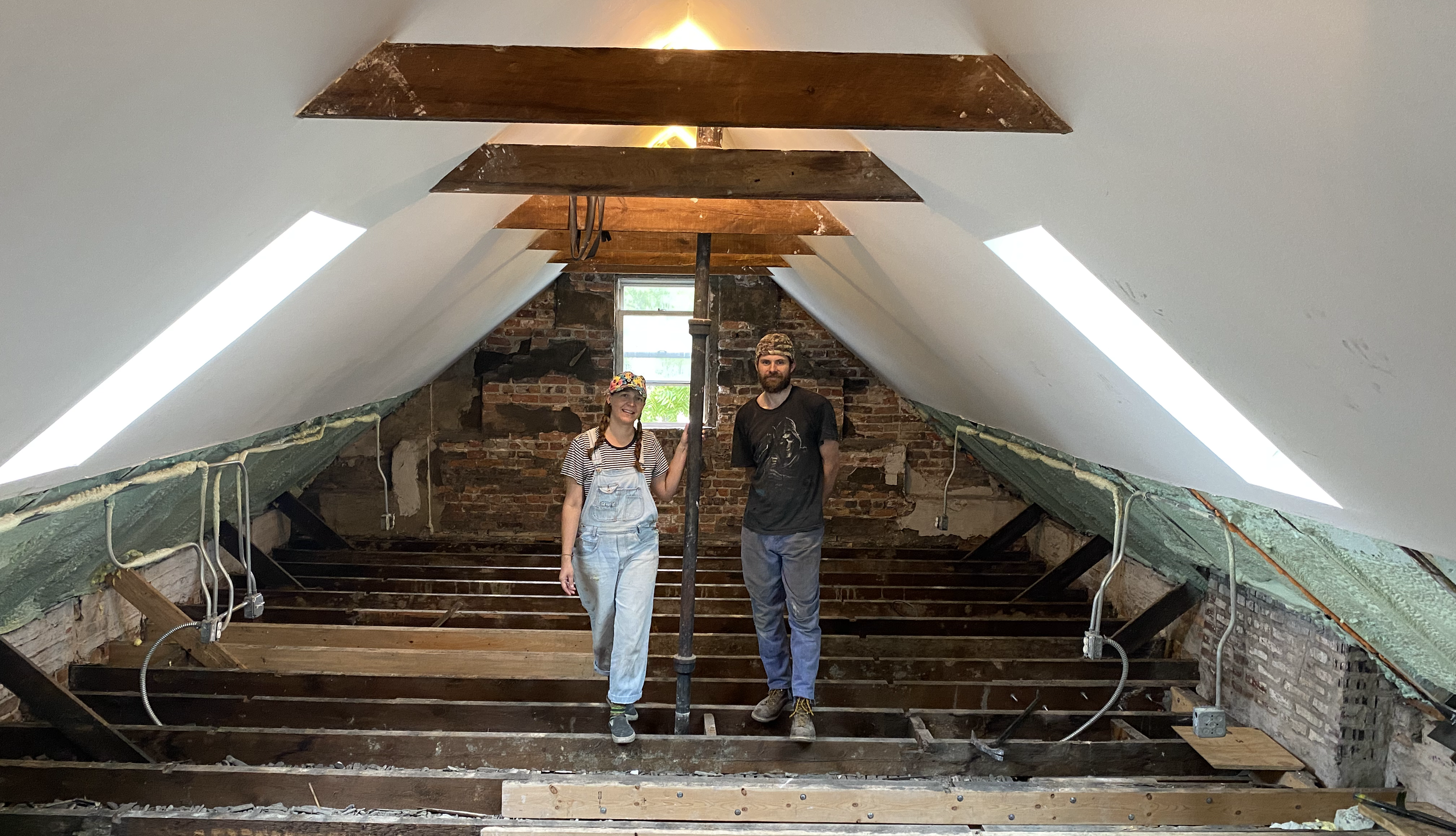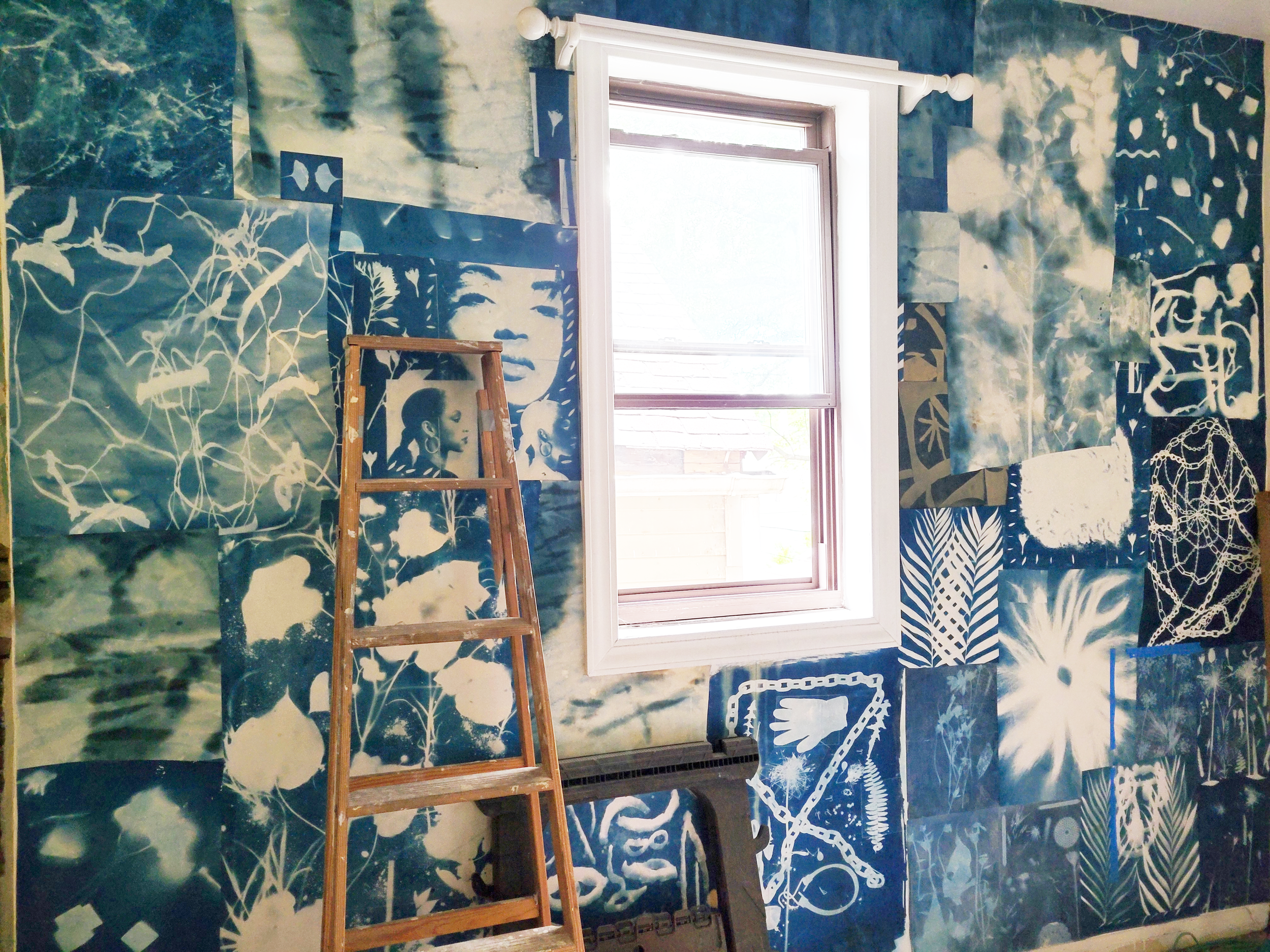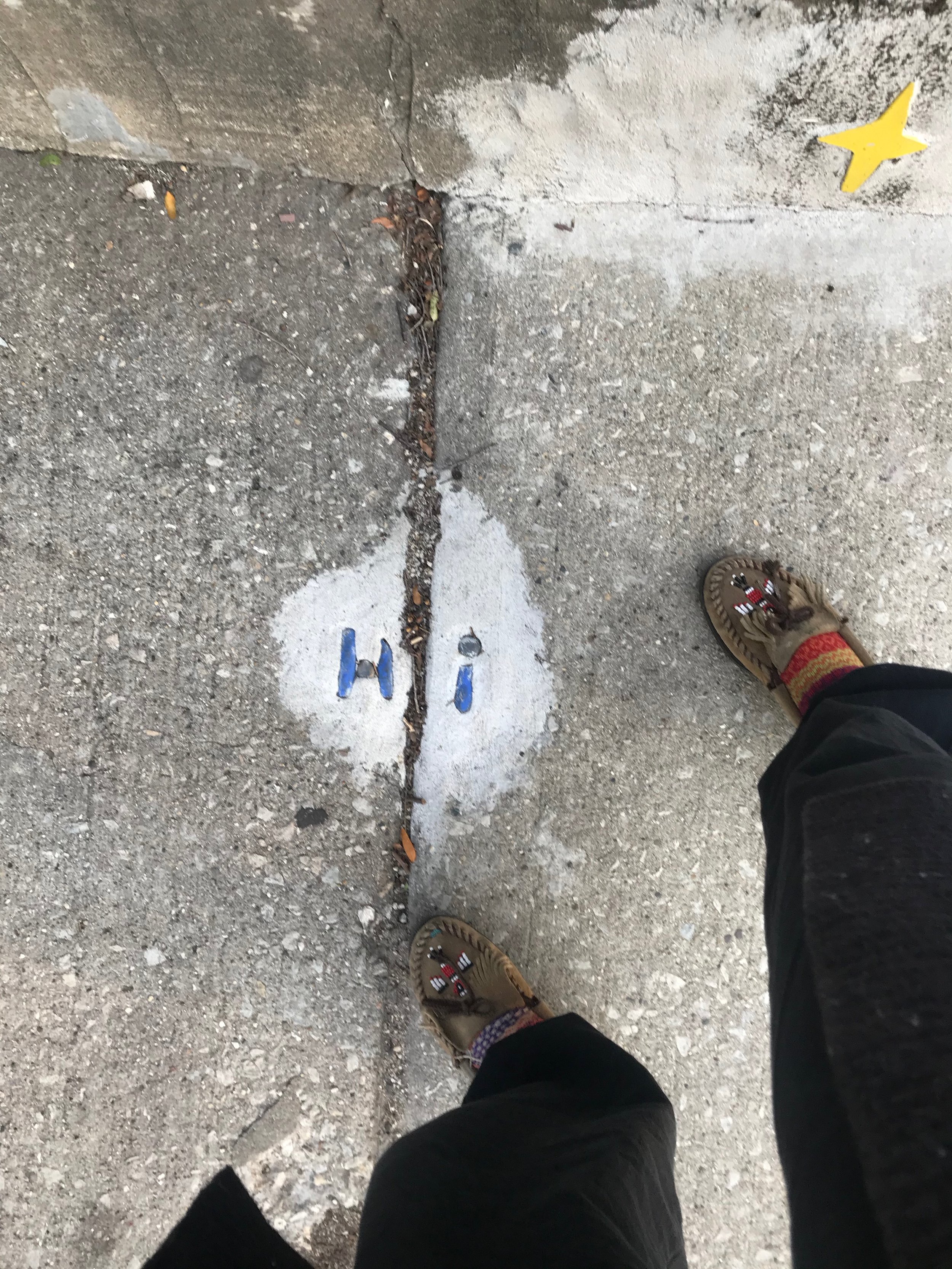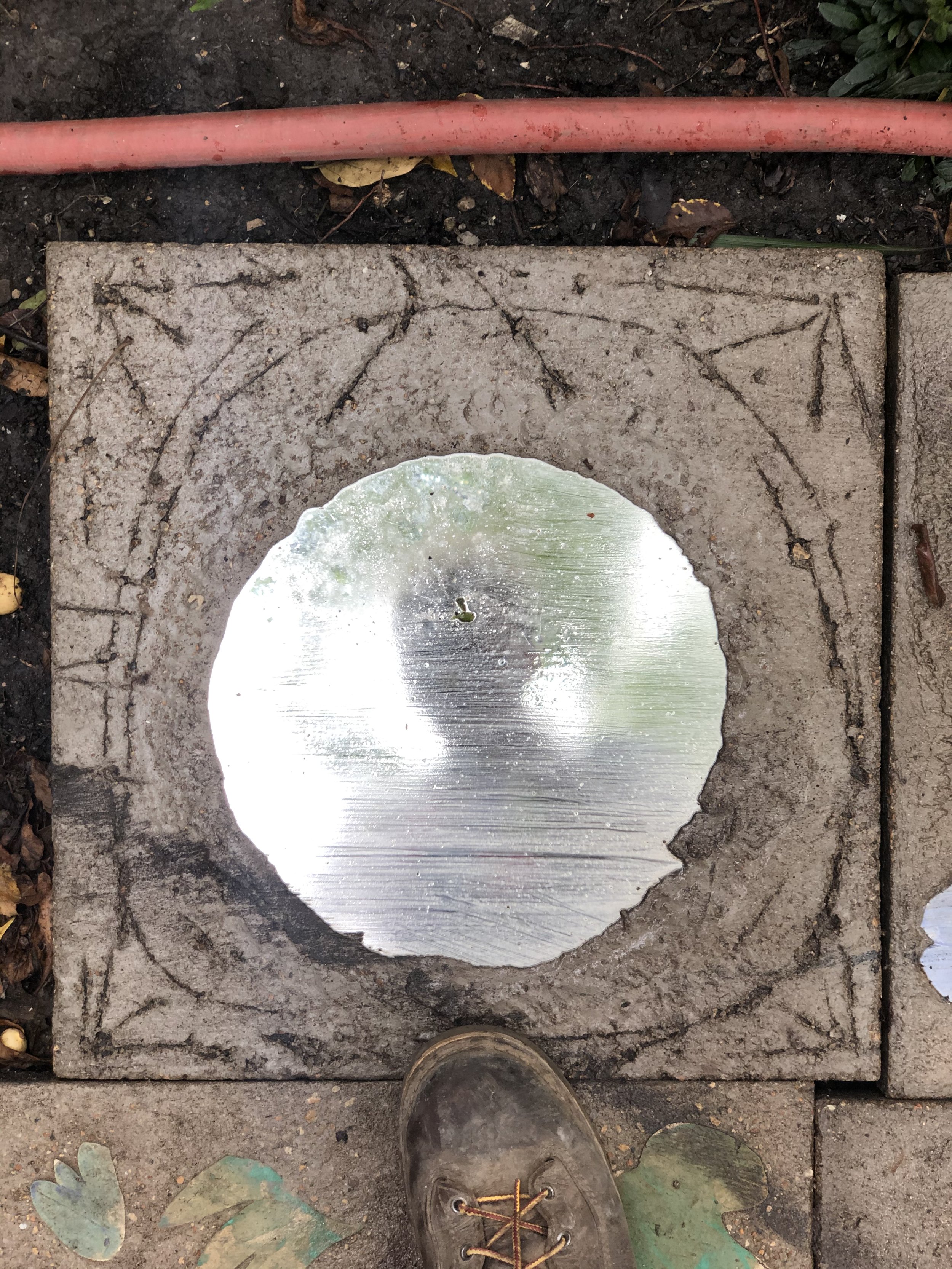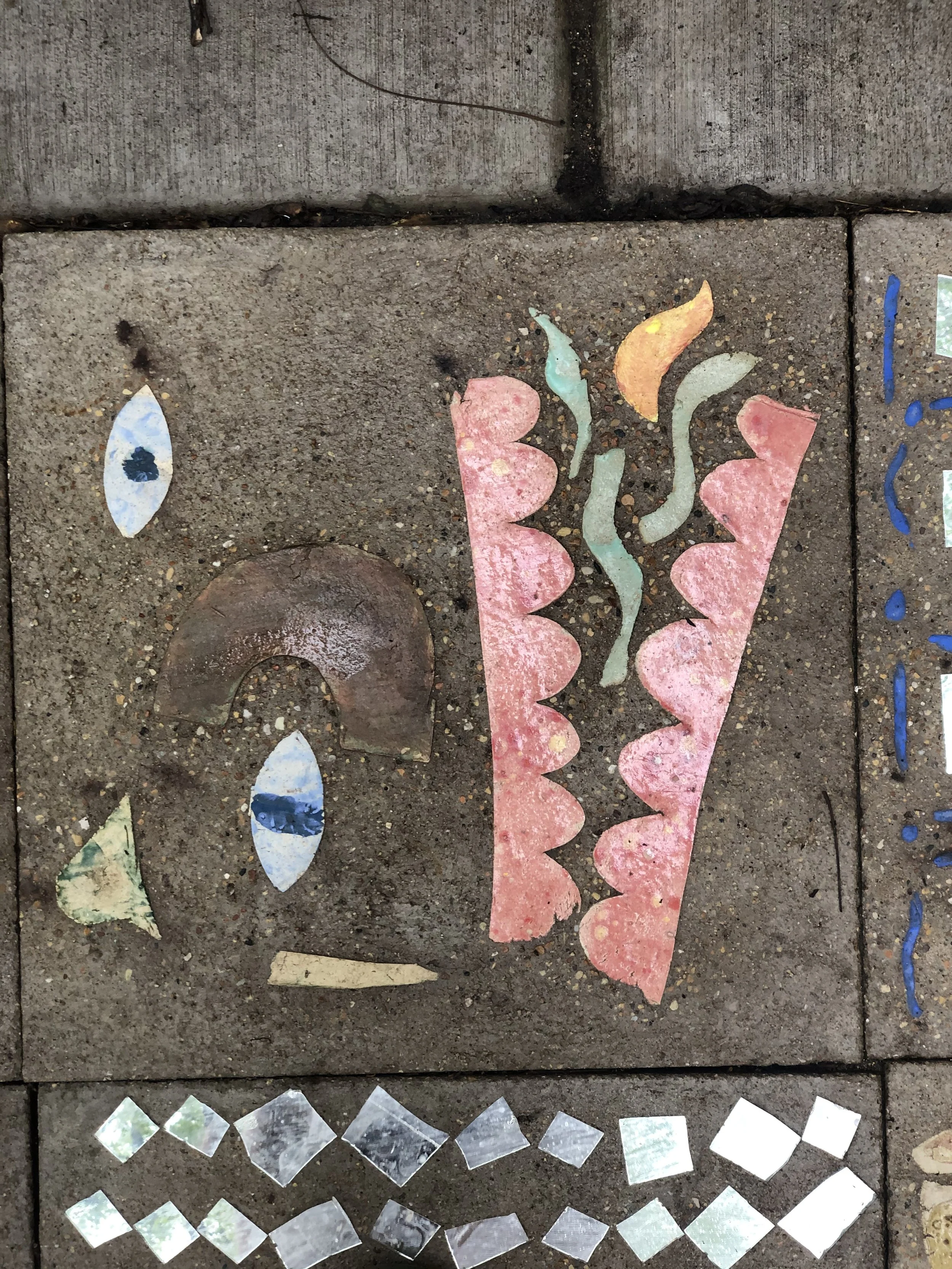Ash Hudson + Ben Driggs:
A Devotion to Process
Two artists in Chicago turn their life and home into a creative practice
By Eva Rogers
Absorption in art is similar to religious worship in freeing one from everyday worries. It is for exactly this reason that art increases as it distances itself from national and social issues and concerns itself more with the purely human—with absorption, with looking and seeing, with the taking leave of oneself [in aesthetic experience].” -Kurt Schwitters
Aerial view of Ash and Ben’s Backyard
I was introduced to the work of Ash Hudson and Ben Driggs in a moment when I was thinking about art and life, what it could mean to live one’s life as an artwork, as a project constantly in progress, constantly in a state of coming into being. I first saw their handmade concrete and ceramic tiles online: a grid of 18 x 18 inch tiles they created to remake their patio. Within the grid, there is an energetic flexibility in the tile patterns, inset with circles and squiggles and mirrors, splotches and faces and zig-zags, curving strips and flecks and triangles. The colors and the freedom of the individual layouts within the larger structure called to me. Ash’s and Ben’s art practices involve many different kinds of processes — ceramics and metalworking, stained glass and cyanotype, drawing and mapmaking, building techniques employed practically and creatively, preservation as an approach to historic buildings and as a method of material reuse.
When I observed their work, when I talked with Ash and Ben, and then when I met them in person in Chicago, I thought about how they are creating art in a way that is not so much a question of "what should I make?" but "how should I live?"
This interview is an edited combination of excerpts from our conversation and written responses from Ash.
Ash was raised in the suburbs of Chicago and Ben was raised in small towns around Illinois and Wisconsin. The two of them moved to California, then returned to Chicago, where they bought their home in the Little Village area in 2014. They’ve traveled extensively in Wisconsin and the Midwest as well as in Hawaii, the West Coast of the US, the Southwest (Utah and New Mexico), the East Coast and New York, Costa Rica, and Baja, Oaxaca, and Mexico City in Mexico.
ER: How did you two meet and start working together?
BEN: We met in art school, we were acquaintances at that point. When we started our relationship, it was based around art: Ash had these constructions she would make, wooden painted assemblages, and I had a battery-powered drill. I thought it would be romantic to help her install this on a wall somewhere. We still kind of do the same thing, just on our own property now.
ASH: I forgot that we did that until we looked at our old pictures — we nailed them to abandoned buildings.
Ben attaching assemblage made by Ash onto building
BEN: Later we moved to California, and saw this place called The Studio [a progressive art studio in Eureka, CA; now called Canvas + Clay]. They needed a ceramics teacher. I told them I knew how to do ceramics. I lied! That was a great job, my favorite job ever. It was the real beginning of my, and our, shift in focus to more of the "unprofessional," untaught side of things.
ASH: In art we gravitated toward how devoted people are to making it. How real and instinctual it feels.
BEN: For me, meeting those artists at The Studio helped me to have a view on what art creation could be for me, without all the things that I learned in art school about professionalism, how to be a successful artist, and what kind of a goal you should have when you're making art. I really wanted to make art like that. And I didn't know how up until then. When I went to art school, what I think I got out of it was a kind of paranoia, and it wasn't working for me. I look back on all the work I made, even years after I was working at The Studio — it took a long time for me to shed the concerns I had gained in art school.
ASH: To unlearn what you're taught.
BEN: How to throw away a lot of the things, like "this is what is good." And I feel good about it now.
ER: I think there’s a distinction to be made regarding art as a way of life: you're living and making it, as opposed to your art being some separate thing, where you're making something that people have to want, something to be sold. I was an English major in undergrad, I did a lot of creative writing there, and in writing workshops — at that time for me, at least — you're generating a creative product in a specific kind of way.
ASH: You're copying what you're learning, or what your teacher is doing, or copying what you find cool at that time, you're not making it just for you.
ER: Thinking about the many folk art environments you have visited over the years — was there a first visit that sparked things for you?
ASH: When we came back to Chicago, we spent a lot of time in Wisconsin, and we went to this place called Dr. Evermore's Forevertron. It was this incredible junk place that this weird old dude made, and he thought it transported you to another planet, or transported aliens down.
BEN: He built these structures with a story behind them. As you entered the structure, you were implicated in this alien-human connection. And it looked really wild and dangerous.
ASH: It was very hands-on.
BEN: The artist was alive at that time, so we got to meet him.
ASH: I wouldn't say it's my favorite place we've been, but it was the first.
BEN: My first was when we moved to Eureka, there was a thing on Saturdays called Arts Alive. The Studio had an open house where the artists made props and costumes for themselves and performed as whatever they wanted. And I remember this artist, Allen Cassidy — we have a piece of his right there. He made a tiger mask and costume. And he was acting like a tiger, but talking, it was totally awesome. And I totally fell in love with it at that point. And I hadn’t really known much about outsider art before that, or really cared that much.
Map made by Ash documenting art environments
ASH: After the Forevertron, we found out about this museum in Sheboygan, Wisconsin that is run by Kohler [the John Michael Kohler Arts Center] and they specifically like folk art from Wisconsin. They had saved a bunch of these environments. We had in our minds that we wanted to go to them all. And the next July, we took a week or two and we went to all the spots in Wisconsin. It was one of our best trips.
Ash and Ben did a Wisconsin art environment tour in 2018, visiting Nick Engelbert's Grandview in Hollandale, Wisconsin; Dickeyville Grotto, WI; Paul and Matilda Wegner Grotto near Cataract, WI; Prairie Moon Sculpture Garden in Buffalo County, WI; Fred Smith's Wisconsin Concrete Park south of Phillips, WI; Rudolph Grotto and Wonder Cave in Rudolph, WI; and the Mary Nohl House outside of Milwaukee, WI. In 2018 they also visited the Grotto of Redemption in West Bend, Iowa (which they’ve deemed the most awe-inspiring grotto).
BEN: I can’t believe it’s not more common — even in our world, having gone to art school — a more common thing to do, to go on a tour of outsider art spaces in the Upper Midwest or even all over the US. It took me so long to find that resource. As an artist trying to be an artist.
ASH: Now we seek that out. Every place we go, we look for some sort of art environment like that.
ASH: The one that was the most moving to me was in Iowa — the same year that we did the Wisconsin trip, we went to The Shrine of the Grotto of the Redemption in West Bend, Iowa. It was the best grotto-slash-art environment I’ve ever been to. There is a campground next to the grotto, it was all open, so we camped and we went in at night with some wine and some friends. It was very magical. This guy devoted his whole life to making this unbelievable thing out of rocks. Friends from around the world sent him rocks from different countries. And it’s just an amazing bejeweled castle of rocks.
ER: How does it feel to be in these spaces in general?
ASH: You can feel the devotion the maker had to these spaces. They are encrusted with beautiful and old things, they have memories, though some of them had religious ideas in mind while making the grottos. I feel a kind of spirituality in these places because of the rocks, crystals, personal trinkets, etcetera. The vibe is peaceful and I feel a connection. It can be a very immersive experience. And I really like imagining these people with very practical lives making such weird, amazing spaces.
Ash and Ben in the attic of their home
ER: How do you think someone starts something like that? I’m curious about the difference between a project that has a closure moment, versus making an ongoing thing that’s essentially a lifetime project. How do you think about the things that you’re working on? For example, how do you start a project, or how do you know which things you’re going to take on as the next piece of a project?
BEN: It is a little chaotic. Part of it is like an avocation. You know, it doesn’t have to stop — you can take breaks, you can do things instead, like go on vacation. But I think with [ Father Paul Matthias Dobberstein at the Grotto of the Redemption ] for example, he was done, basically, when he was about to die. He still had plans that were incomplete. And other people worked on it, as far as I know, after he died.
ASH: He even worked on it in the winter — they showed little things he would do inside to get ready for the summer. He was very devoted, and obsessed.
BEN: You can’t start concrete in the winter, it won’t cure outside. So you just make these huge — many hundreds of pounds — panels of concrete, like a medallion, and then you go place that. And every year you make several medallions and then you work outside all summer. But with this work of ours, it might not be the most appropriate location to have a never-ending project until you die. It would be better to have more open space.
ER: How did you choose this house?
ASH: It was boarded up across the street from my friend’s house and I thought it was magical. It was not for sale. A year later I saw it when casually looking for houses online. It sat for two years. The neighbors told us it sat for over ten years in the past and called it the “Frankenstein house.” It was a huge hassle to buy, because someone had ripped out a lot of the electrical and ruined the toilets, making it uninhabitable. We had to get a special loan and jump through a lot of hoops. I was ready to give up, but Ben stuck with it. The house is from 1891. At the beginning, I’d just come out of school for historic preservation (at College of the Redwoods), I was obsessed with finding out the history behind it. We found out that the man who built the house was a plaster worker, he did a lot of the old plaster walls behind the drywalls. They just put new floors and walls over a lot of the old stuff. So some of the original material is there, the wood floors and some of the plaster walls. It was cool to find out he was a craftsperson.
ER: Are you removing the drywall and going with the plaster wall?
BEN: We’ve done it in one spot back here, Ash restored a plaster wall that was getting wet, because we needed a new roof. The spot where we took the drywall off had this cool paint job, it’s dyed in the plaster. So she restored that. But in our new place, I don’t know how we’re gonna handle that. There is a wall that we could bring back to plaster. We might be bringing back the wood floors, for sure. We’re taking out a lot of walls, so it’s going to be a little bit more open than it was originally.
ASH: We’re trying to minimize what we’re buying, buying things secondhand, finding a clawfoot tub, making what we can; we’re even trying to reuse drywall. We have a process where we’re taking all the nails out of the drywall and saving it — we don’t need to make any more waste in the world. And the attic floor upstairs is Douglas Fir, which is softwood. But we may use it as our finished floor. We’re thinking about saving all that.
ASH: This is our biggest project yet, going on right now.
BEN: It’s not artistic, not yet.
ASH: I think it is. A lot was put on this house that is just bogging it down. And we’re stripping it away and restoring it. And eventually we’re going to add artistic elements.
BEN: The project that we’re working on now is fixing our apartment up into the attic, and then taking over the whole attic. So it’s less just embellishment, and more beautifying and reorienting the structure. I’ll be using conventional construction techniques to do all that.
ASH: We’re also restoring it. We’re redoing the floors and redoing some of the plaster. We’re going to make our own stained glass windows. I think that’s a different kind of art, restoring a house, or taking away things that aren’t serving it.
Handmade cyanotype wallpaper
ER: Does Chicago itself set the stage in any way for the work you are doing here? Does anything about Chicago inspire this work, or do you do the work here simply because you live in Chicago?
ASH: I was thinking no at first, but then I remembered Edgar Miller was an artist and architect here who has definitely influenced us. He built his houses, designed the interior stained glass, wallpaper, and furniture. Our neighborhood and the one next to us are rich in yard shrines and art, and Doctor Charles Smith made an amazing and moving yard environment in the ‘burbs of Chicago, proving you can do it anywhere.
ER: You mentioned the sense that there might be an “ideal” spot to do this kind of art, these projects, that might be different from the space you have. This makes me think about constraints — is there a way in which you could say, “I might not have done that thing if it weren’t for this quirky thing I have to try to address?”
ASH: Everything we’ve done so far has started out functional. I wanted to do the backyard. And Ben said, “Well, I just went to Howard Finster’s place. And he made these awesome tiles — we can do it ourselves.” It starts functional, and then we ask, how can we make it our version of that?
BEN: Yeah, it starts functional. There was a tile that Finster made — I saw a tile at his house that directly led to the yard project. It’s just a 10 by 10 tile, I think it was really thin, like an inch and a half. Because it’s Georgia, so it’s not going to freeze, I guess. It just had four small, like three-inch square green tiles. That’s it, I thought it was amazing.
BEN: As far as a perfect place to do this kind of thing — it would be somewhere with no oversight. No potential for it to get condemned, or taken away, or gated off and protected from people. There are places around the city here in Chicago where they’ve been forced to remove sculptures from their yard because it’s, like, an eyesore.
ASH: That kind of stuff can happen anywhere.
ASH: I think for us, this is just the beginning. At first, we weren’t thinking about the house as an art project, that has started recently. It started with Ben making things that then we would incorporate into the garden. He did some chainsaw projects. Then he made all the flower pots in our house. I did a garden project. Then we made our own wallpaper. It’s been a slow building. Maybe we won’t have the same kind of art practice we used to have, but this is what we’re doing now, and I think it’s just the beginning. I think we’re gonna get weirder and older.
BEN: The cool thing about having to be in the city, and doing conventional stuff, is that you can make it your own, do it yourself. Like the wallpaper, or choices about what kind of wood we’re going to use. Where are we going to put it? How often will we embellish this little part? Hopefully we can do it all and maybe the constraints of having to do it in this little footprint will end up helping us narrow down what it is that we are going to do with our limited time, and strength.
ASH: We also made these really cool things we call earrings. They’re these aluminum dangly sculptures that are affixed to the side of the house and you can see them from the train. [ Ben built a special furnace to cast and create these aluminum earrings. ]
BEN: That started with the building too, because there was an empty spot on the garage wall, and I was like, Wow, that’s a perfect spot for something — so that’s why we’ve made it the scale that it is.
Earring on side of house
“Hi” outside front of house
ER: I’m thinking again about the tile project in your backyard. I’m curious about the material. Are those ceramic insets that make up the patterns?
BEN: We made all the shapes. I work for an artist and we had a lot of extra clay, so we processed all that, and made a huge layout of all these clay shapes, just kind of riffing. And then we glazed and fired them and made molds in the garage to cast the tiles. We did it in layers, different kinds of concrete, and we did 20 at a time. Then we composed the tile with the ceramics, and used a board and a little jackhammer to vibrate it down into the concrete, and clean it all up. Some of them have mirrors, and glass. And shells.
ASH: At first, we were just making them with the thought that we’ve got to get them done. But then toward the end, there was more deliberate thought about what the design of each tile would be.
BEN: That is a competing urgency, having to work really fast. Because the scale of it is so big, the effort is so big. And it does hurt to do all that, it hurts your back and arms. If we were to do it again, I don’t know if we would take more time.
ER: It’s definitely different to make 100 tiles versus making one tile, for some very specific purpose — that’s a very different scale. How much time you can invest, how much time you have to make that sort of thing.
ASH: We have different thoughts about time — he likes to get things done faster. And I’m a little slower. I know we have time crunches, but we have different scales of time and urgency. The tile thing was our COVID project. So we had time. But it was more than just making the tiles — Ben also had to make sure that the backyard was dug out in the right way. Different kinds of rocks were layered —
BEN: It’s actually a permeable thing.
ASH: — and then tamped down. He rented a dump truck.
BEN: We literally filled up a dumpster with dirt. A dumpster that punched through the garage floor.
ER: Back on the tile, the making of the tiles — I was curious if it was freeform in terms of shape creation? Or were you developing a language of shapes?
BEN: Speaking for myself, I ran out of shapes pretty quickly. And then I just started getting them out. Hands took over. Some of them are really good, some of them are — It’s kind of like a sketchbook where every page got made into a tile.
ASH: Some of our friends made a few and my nephew made one, a cool one of cats. Like I was saying at the beginning, Ben just made a whole sheet of shapes and we just do whatever with the shapes. But toward the end we had designs and then made the shapes for what we wanted to do. We have a few that are artist-inspired, there are some Matisse ones and some Picasso and — the guy who makes the mirrors —
BEN: Higinio V. Gonzales. Someone did this research and identified that one guy made all these significant tin work mirrors and reliquary-type church architecture. There’s a book of his stuff that is really interesting, with some round mandala mirror shapes — we made a copy of one of those with a mirror in it.
BEN: So when we finally laid the tiles down, we had an opportunity to edit a little bit, like what tiles are going to be where, we could hide some of them or cut some of them. And that’s a point of contention, because some of them should not have gotten cut into pieces. And some of the ones that are featured should be hidden. We can always change them.
ASH: Except for the cut ones.
ER: I was hearing “cutting” in two ways — I thought you meant “cut” like the editing process. Now I see it sounds like you actually physically cut some of the tiles.
ASH: Ben had a giant wet tile saw to cut these.
BEN: I just had a thought related to the saw. When I was in art school, I was always obsessed with process, learning new processes and new techniques. And being a beginner was really seductive, because it kind of doesn’t really matter what you do. So when we have this house project, we get to learn how to do everything. Like, oh, there’s this awesome tile saw? How does that work? Can we figure out a way to use it to build our house. And that’s an example of that. Part of all the other stuff we’re doing — new tools, new techniques — we took these studs, old growth Douglas Fir studs out of our house, and we could learn how to use a shaper and cut them into trim. The process generates projects and ways of thinking. The trim I was thinking we could make would be like a profile — like half of the letter A and half of the letter B. It could conceivably look like a piece of trim, but it’d be our names.
ER: The tile project is a really large-scale project. Has there ever been a project where you say, that project is too big to think of? Or do you just have an idea, and then you say — it’s big but we’ll just give it a go?
ASH: No, I think he says every time that the project is too big, and then we go and make it much bigger.
BEN: Yeah, that’s exactly what happens. Make it much bigger! I’m like, if we’re gonna do it, we’re never going to do this again. So let’s just do it right, do the best we can. But then the time thing comes in, and it becomes kind of maniacal.
ASH: I say I want to fix something up, Ben says it's too much work, then changes his mind and says let’s do it, but in an even more complicated way than you were thinking. For example — I said we should fix up the backyard to make it usable, Ben was only on board if we made all the tiles/pavers ourselves, with a thorough drainage system. He is more thorough than me, I'm like, let’s just do it, and he likes to make the plans and do it right. I say I want a normal-sized bathroom and kitchen counters, and Ben says it’s too much work, nah. Then — actually, let’s do it but reimagine the whole thing.
ER: Is being "done" a possibility? Do you envision working on this home and related projects in an ongoing way “forever”? Or is there a time frame for you?
ASH: Probably not — I've already been thinking about what I’d like to work on next summer.
George the cat chilling out back
All images courtesy Ash Hudson & Ben Driggs
Follow along on Instagram: Ash - @fadedtator, Ben - @ben.driggs
Eva Rogers is a writer, editor, designer, fundraiser, and multifaceted storyteller. Finder her @rogevarog // evarogers.com




